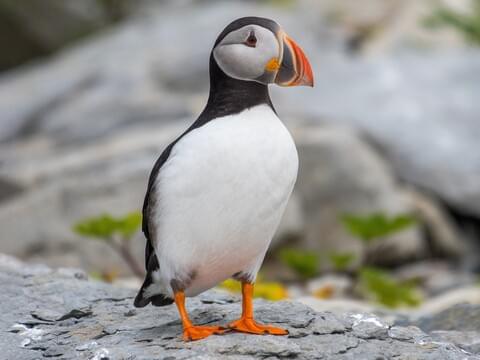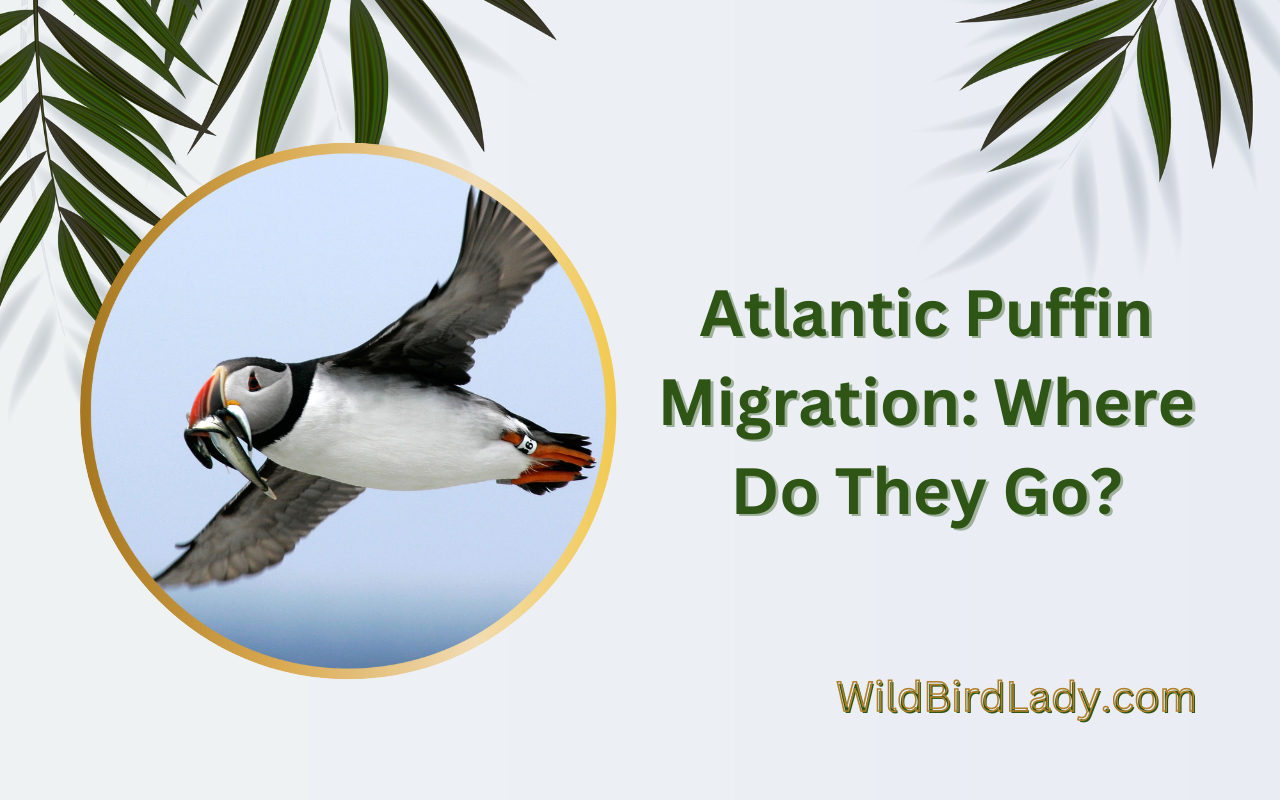Atlantic puffins migrate to spend their winters in the open ocean. These birds breed and nest on coastal cliffs of north atlantic islands, including iceland and Greenland.
In the late summer and early fall, they leave their nesting colonies and head out to sea, where they spend the winter months. As summer comes to an end and the autumnal air carries a crisp breeze, millions of seabirds embark on their long migratory journeys.
Among them, the atlantic puffin is one of the most iconic and beloved. These charming birds, known for their brightly colored beaks and comical waddling, spend their breeding season nesting on rocky offshore islands in the north atlantic. But once the young have fledged and the season is over, the adult birds take flight, leaving their island homes behind and heading out to sea. In this article, we’ll explore where these charismatic seabirds go when they begin their journey, and the challenges they face along the way.

Credit: www.allaboutbirds.org
The Life Of The Atlantic Puffin
With their oversized colorful beaks, atlantic puffins are among the most recognizable seabirds in the world. These charming little birds spend most of their lives at sea, only coming onshore to breed. Here are some interesting facts about their appearance and behavior:
Appearance And Behavior
- Atlantic puffins are small birds, measuring only about 10 inches long and weighing only a pound or two.
- They are easy to spot, with their black backs, white bellies, and colorful beaks.
- Their beaks are brightly colored during the breeding season, ranging from orange to yellow and blue, and are used to attract a mate.
- Atlantic puffins are excellent divers, using their wings to swim through the water to catch fish.
- They can stay underwater for up to a minute, diving to depths of up to 200 feet.
- Despite being skilled swimmers and divers, atlantic puffins are not very good at flying. They flap their wings quickly, making them look like tiny helicopters as they take off from the water and fly awkwardly through the air.
Life Cycle And Breeding Habits
Atlantic puffins are monogamous and mate for life. They live in large colonies, nesting in burrows on steep coastal cliffs. Here are some key points about their life cycle and breeding habits:
- Puffin pairs typically lay a single egg each breeding season, which is incubated for around six weeks.
- Chicks are born helpless and are fed regurgitated fish by their parents.
- After four to six weeks, the chicks become independent enough to leave the nest and learn to fly and fish on their own.
- Atlantic puffins typically return to the same breeding colony each year, often reusing the same burrow.
- After the breeding season ends, atlantic puffins leave their colonies and spend the rest of the year at sea, migrating to different areas depending on the time of year and availability of food.
Atlantic puffins lead fascinating lives, spending most of their time at sea and coming to shore only to breed. These little birds are skilled divers and monogamous creatures that return to the same breeding colony each year to raise their young.
Migration Routes
The atlantic puffin migration is a fascinating topic for bird enthusiasts. These birds travel long distances from their breeding grounds to spend the winter in the ocean. In this blog post, we will discuss the migration routes of atlantic puffins based on their breeding grounds and the factors that influence their travel patterns.
Understanding Atlantic Puffin Migration Patterns
Atlantic puffins are seabirds that breed in temperate and subarctic regions of the north atlantic. They spend most of their lives (almost 8 to 9 months) in the ocean, migrating twice a year for breeding and overwintering.
Breeding patterns and migration distances:
- Atlantic puffins breed in colonies, and each bird returns to the same breeding site every year.
- Breeding patterns differ depending on the location. Puffins in the west atlantic ocean breed in late march and early april. In contrast, those in the east atlantic ocean breed from april to june.
- The average migration distance of puffins is around 1000 to 2000 km. However, some birds can migrate up to 4500 km, depending on the location of their breeding sites.
Factors affecting migration:
- Weather and ocean currents are the primary factors affecting the migration patterns of atlantic puffins.
- Puffins follow the ocean currents carrying the food they need for the winter season.
- They also utilize the prevailing winds to enable them to travel at the highest speed, thereby reducing the time spent in the ocean and conserving energy.
Where Do They Go And Why?
Atlantic puffins migrate to the ocean to find food sources for the winter season. Puffins’ diet mainly consists of small fish, but they also feed on small crustaceans and squid.
Migration routes:
- Puffins in the west atlantic ocean migrate southward towards the coast of the eastern united states and canada.
- Birds breeding in the east atlantic migrate southward towards the norwegian sea, which is renowned for its abundant food sources for seabirds.
- Some birds migrate to the waters off the coast of the british isles, where they take advantage of the nutrient-rich currents generated by the mixing of the atlantic and north sea waters.
Atlantic puffin migration is an incredible natural phenomenon. The understanding of migration patterns and factors affecting these patterns provides valuable insight into the lives of these magnificent seabirds.
Challenges And Conservation Efforts
Atlantic Puffin Migration: Where Do They Go?
Atlantic puffins are fascinating birds that are known for their colorful beaks and their ability to dive deep into the waters to catch fish. But did you know that they embark on an epic migration journey every year? Let’s take a closer look at where they go and the challenges that they face along the way.
Threats To Atlantic Puffin Migration
Atlantic puffins face a number of threats during their migration journey. These include:
- Climate change: As the oceans warm, it affects the availability of the puffins’ prey, making it harder for them to find food.
- Overfishing: The commercial fishing industry can sometimes overfish the same types of fish that the puffins depend on for survival.
- Seabird predators: Other birds, such as gulls and skuas, can prey on puffins during their migration journey.
Conservation Efforts To Protect Puffin Population
Several conservation efforts have been made to protect the atlantic puffin population. These include:
- Protection of nesting areas: Many conservation groups work to preserve important puffin nesting habitats to ensure that they have safe places to lay their eggs and raise their young.
- Reduced fishing quotas: Governments and organizations have implemented fishing quotas to prevent overfishing the same types of fish that puffins need to survive.
- Climate change action: Many organizations work to reduce greenhouse gas emissions and promote policies that combat climate change and preserve the puffins’ natural habitat.
The Atlantic puffin migration is an incredible feat, but it has its challenges. By implementing conservation efforts, we can help ensure that these iconic birds continue to thrive for years.
Research And Future Prospects
Studying Atlantic Puffin Migration
Researchers have been studying the atlantic puffin migration for decades, trying to unravel the mysteries behind their incredible migration journey. Below are the key points on what researchers have found so far:
- Atlantic puffins are capable of travelling thousands of miles in search of food.
- They have an impressive sense of direction, allowing them to navigate back to their breeding grounds each year.
- Researchers use various methods to track their movements, including gps tracking devices attached to their legs and satellite imagery.
- By studying the puffins’ movements, researchers can determine the locations where they find food and adapt conservation measures with data-driven management plans.
The Future Of Atlantic Puffin Migration
As the world continues to change, and ecosystems shift, it’s becoming increasingly essential to understand the effects of environmental change on atlantic puffin migration. Below are key points to consider for the future of puffin research:
- As climate change continues to alter our planet, research will need to look at its effects on atlantic puffin’s migration.
- Puffins’ food is mainly small fish species like sand lance, which in turn feed on zooplankton. It is essential to study how climate change impacts zooplankton populations and what this means for puffin food availability.
- Plastic pollution and overfishing are also significant threats to the puffins’ food source. Researchers are exploring how both issues are affecting puffin populations and their food availability.
- With innovative research methods such as cameras, satellites, and acoustic technology, researchers will develop more accurate and in-depth data on puffin migration patterns, and, in turn, aid in protecting this incredible migratory bird species.
The study of atlantic puffin migration is a crucial part of understanding the mysterious journeys they take each year and the problems these birds are facing in a rapidly changing environment. With better research techniques and innovative technology, more substantial progress will be made to protect this precious seabird and their habitats for generations to come.
Frequently Asked Questions
What Is The Atlantic Puffin Migration?
The atlantic puffin migration is the annual movement of puffins from their breeding grounds to wintering areas. Some puffins migrate hundreds of kilometers to reach their destination.
Why Do Atlantic Puffins Migrate?
Atlantic puffins migrate to find food. Puffins can’t find food in breeding areas during winter months,
so they fly south to feed. They also migrate to avoid harsh weather and predators in the breeding grounds.
How Far Do Atlantic Puffins Migrate?
Atlantic puffins fly up to thousands of kilometers during migration, depending on the location of their breeding grounds. Puffins breeding in iceland may travel up to 1,000 km to reach the wintering areas in the north atlantic.
How Do Scientists Track The Puffin Migration?
Scientists track puffin migration through a variety of methods. They use satellite tags, geolocation, and wind drift modeling to follow the birds’ movements. Observations from birdwatchers and citizen science programs also contribute data.
When Is The Best Time To See Atlantic Puffins During Migration?
The best time to see atlantic puffins during migration is from late spring to early summer. This is when the birds are returning to breeding grounds and may be seen in large numbers along coastlines. However, specific timing and location may vary depending on the breeding area.
Conclusion
So, there we have it! The atlantic puffin migration is one of the most fascinating wonders of nature. These adorable birds embark on their incredible journey twice a year, flying to and from their breeding grounds. They face various threats along the way but their unique features help them to survive in harsh conditions.
As we have learned, puffins are incredibly resilient, adaptable, and well-equipped to navigate the often-treacherous waters of the atlantic ocean. Through these journeys, they have gained many admirers and helped researchers learn more about this incredible bird species. As we continue to study these amazing birds, we can ensure their preservation.
It is important that we respect their habitat, aid in conservation efforts, and continue to be amazed by these incredible creatures.
Latest Posts
The Ultimate List: Top 8 Best Birdwatching Podcasts for Avid Birders
Looking for the top birdwatching podcasts? Here are the eight best options to tune into today! Birdwatching can be a thrilling, immersive experience that brings...
Stop Squirrels in Their Tracks: 10 Effective Ways to Safeguard Your Bird Feeder Pole
To prevent squirrels from climbing your bird feeder pole, use squirrel baffles and slippery poles. Here are ten effective ways to keep squirrels from stealing bird food and damaging bird feeders. ...


